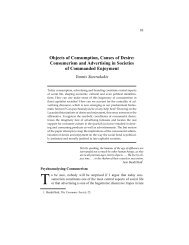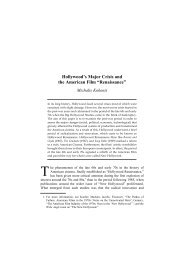19 International Symposium on Theoretical and Applied Linguistics ...
19 International Symposium on Theoretical and Applied Linguistics ...
19 International Symposium on Theoretical and Applied Linguistics ...
Create successful ePaper yourself
Turn your PDF publications into a flip-book with our unique Google optimized e-Paper software.
G E N E R A L S E S S I O N<br />
υποκειµένων, που έλαβαν µέρος στην έρευνα, συγκρότησαν 1585 µαθητές και µαθήτριες της Γ΄ τάξης<br />
του Λυκείου και 420 φοιτητές και φοιτήτριες διαφόρων Α.Ε.Ι. & Τ.Ε.Ι.<br />
Επιµέρους στόχοι του ερευνητικού µας σχεδιασµού είναι να εξετασθεί: α) το είδος των γλωσσικών<br />
µεταβλητών µε λόγια συνιστώσα, που εµφανίζονται στον ηλεκτρονικό λόγο των νέων, β) οι ιδιαίτερες<br />
κοινωνιοπραγµατολογικές (socio-pragmatic) λειτουργίες, που αυτές επιτελούν, γ) οι εξωγλωσσικές<br />
παράµετροι (ηλικία, φύλο, τόπος καταγωγής, µορφωτικό επίπεδο γονέων, κοινωνικοοικονοµική<br />
κατάσταση οικογένειας), που καθορίζουν τη χρήση τους.<br />
Sluicing <strong>and</strong> asymmetries in the CG wh-questi<strong>on</strong> formati<strong>on</strong><br />
Antri Kanikli<br />
University of York<br />
ak569@york.ac.uk<br />
This paper proposes an approach to sluicing based <strong>on</strong> the asymmetries exhibited in certain whquesti<strong>on</strong>s<br />
in Cypriot Greek (CG). In particular, I suggest that in sluices, at least in CG, <strong>on</strong>ly the<br />
element occupying the specifier of CP may appear as a sluicing remnant.<br />
CG displays two wh-formati<strong>on</strong> patterns, the <strong>on</strong>e is similar to the St<strong>and</strong>ard Modern Greek (SMG)<br />
wh-pattern (1a) <strong>and</strong> the other includes embu (1b), which is reminiscent of wh-strategies occurring in<br />
French, Portuguese <strong>and</strong> Northern Italian dialects.<br />
(1) a. Pcos emilise? b. Pcos (embu) emilise? (2) Inda *(’mbu) thelis?<br />
who.NOM spoke.3SG who.NOM (is-that) spoke.3SG what.ACC (is-that) want.2SG<br />
“Who has spoken?” “Who has spoken?” “What do you want?”<br />
Intriguingly, the applicati<strong>on</strong> of the embu strategy is compulsory in inanimate wh-arguments<br />
introduced by the dialectal inda (2), whereas it is opti<strong>on</strong>al in animate wh-arguments (1b).<br />
A split-CP analysis in the framework of Rizzi (<str<strong>on</strong>g>19</str<strong>on</strong>g>97) is proposed for the peculiar embu wh-strategy.<br />
I argue, c<strong>on</strong>tra Grohmann, Panagiotidis <strong>and</strong> Tsiplakou (2005), for a m<strong>on</strong>o-clausal analysis of these<br />
wh-c<strong>on</strong>structi<strong>on</strong>s, based <strong>on</strong> evidence drawn from the syntactic positi<strong>on</strong> of negati<strong>on</strong> <strong>and</strong> sentential<br />
adjuncts, <strong>and</strong> the properties of en (n<strong>on</strong>-inflecti<strong>on</strong> for tense, pers<strong>on</strong> <strong>and</strong> number). On the basis of this<br />
analysis, I re-examine the asymmetries occurring in embu wh-interrogatives. The different syntactic<br />
behavior of the dialectal inanimate <strong>and</strong> animate wh-arguments with respect to sluicing, is crucial to the<br />
account proposed for the asymmetry exhibited in between them. In particular, ’ndambu (a c<strong>on</strong>tracted<br />
form of inda <strong>and</strong> embu) may appear as a sluicing remnant (4b), whereas in animate wh-arguments, a<br />
wh-word cannot co-occur with embu in sluicing c<strong>on</strong>structi<strong>on</strong>s (3b). Sluicing is c<strong>on</strong>sidered to involve IPdeleti<strong>on</strong><br />
(see am<strong>on</strong>g others Merchant (2001), Lobeck (<str<strong>on</strong>g>19</str<strong>on</strong>g>95); however, this stipulati<strong>on</strong> is not always<br />
verified, as verbs, which typically raise to the C domain in interrogatives, are also being deleted in<br />
sluicing c<strong>on</strong>structi<strong>on</strong>s. Thus, it is proposed that <strong>on</strong>ly the elements present in Spec,CP are eligible to<br />
be sluicing remnants in CG. In these terms, ’ndambu is suggested to have been reanalyzed as a<br />
single wh-element, which occupies the Spec,CP; hence it is licensed to appear in sluices, whereas<br />
embu <strong>and</strong> the raised verbs, are being deleted.<br />
(3) a. PCOS? (4) a. *INDA?<br />
who.NOM.SG what.<br />
b.*PCOS EMBU? b. ’NDAMBU?<br />
who.NOM.SG is-that what-is-that<br />
C<strong>on</strong>clusi<strong>on</strong>: This approach to sluicing, although it diverges from Merchant’s account, is in accordance<br />
with the sluicing-COMP generalizati<strong>on</strong> stipulated by himself (2001) in order to account for phenomena,<br />
which c<strong>on</strong>tradict the idea of IP-deleti<strong>on</strong> in sluicing. Furthermore, <strong>on</strong> the grounds that sluicing is a<br />
focalizing strategy, the suggested approach reflects current minimalist c<strong>on</strong>venti<strong>on</strong>s, according to<br />
which an element in order to receive an interpretati<strong>on</strong> by the interface levels, it must be located in an<br />
edge positi<strong>on</strong> (Chomsky 2002). Therefore, the sluicing remnant, which receives in the SC <strong>and</strong> PC the<br />
relevant focusing interpretati<strong>on</strong>, is the <strong>on</strong>e located in Spec,CP, an edge positi<strong>on</strong>.<br />
<str<strong>on</strong>g>19</str<strong>on</strong>g> th ISTAL 23






